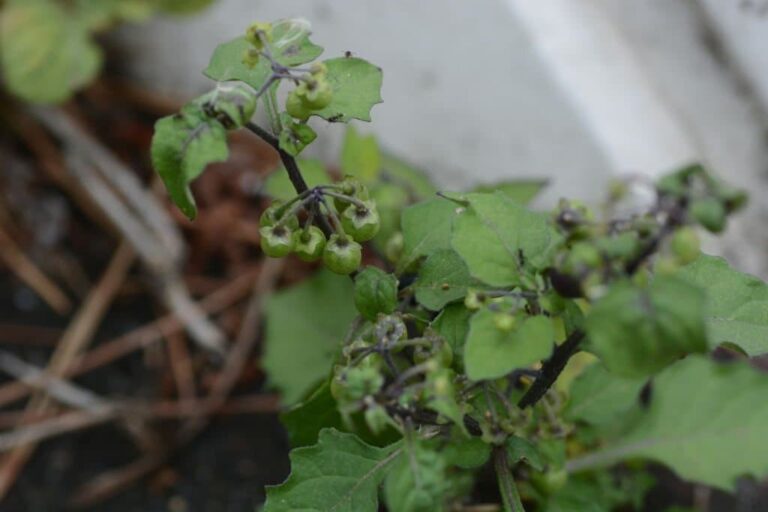25+ Types Of Ficus Trees To Grow Indoors And Outdoors (With Pictures)
A fascinating and exotic addition to any home or office, the ficus tree offers a unique charm. With numerous types to choose from, each with its own distinct characteristics, size, and care requirements, it’s no wonder why many people opt for these versatile plants. This blog post will delve into the world of ficus trees, exploring their various species, how to care for them, and the benefits they bring to our surroundings.
What is a ficus tree?
A tropical gem, the ficus tree is a member of the mulberry family that thrives in Asia, Africa, and Australia. Its impressive height can reach up to 50 feet, accompanied by its signature glossy green foliage. Notably, the ficus tree is renowned for its ability to bear fruit throughout the year, with small, vibrant red fruits being a characteristic feature. This low-maintenance plant has become a popular choice as a houseplant due to its tolerance of limited sunlight.
Its versatility also extends to bonsai cultivation, where it can be carefully trained to assume various shapes and forms. Moreover, the ficus tree has been utilized in traditional medicine, with its bark being used to alleviate diarrhea and its leaves employed to treat wounds.
Facts about ficus trees.
In addition to being a staple in many homes due to their low-maintenance nature and ability to thrive in low-light conditions, ficus trees have a rich history and fascinating facts surrounding them. For instance, they belong to the Moraceae family, which comprises over 750 species of plants, making them part of a vast and diverse group. Ficus trees are incredibly adaptable and can be found in a wide range of climates, from the lush tropics to arid semi-deserts.
This adaptability is reflected in their impressive growth rate, with some wild ficus trees reaching heights of 30-40 meters (100-130 feet). Beyond their physical characteristics, ficus trees hold significant cultural and spiritual value, being considered sacred in many societies and having been used in religious ceremonies for centuries.
Furthermore, these remarkable plants provide a habitat for a wide variety of animals, including birds, bats, and monkeys, making them an integral part of their ecosystems.
Ficus tree meaning.
The Ficus tree has long been a favored indoor companion, boasting multiple layers of symbolism. Notably, this versatile plant is often associated with new beginnings, fertility and good fortune. Its presence in a home is also said to cultivate an atmosphere of serenity and tranquility, making it an excellent choice for those seeking to infuse their living space with positivity.
How to identify a ficus tree.
Ficus trees are instantly recognizable due to their unique leaf morphology. A closer inspection reveals large, leathery leaves that grow in a rosette pattern, featuring a glossy finish and distinctive veining. The bark of the tree is smooth and brown, while the branches are sturdy and robust. When you come across a tree with these characteristics, it’s likely to be a ficus tree.
In addition to their leafy appearance, ficus trees are also defined by their fruit.
The small, fleshy clusters of fruit that grow on the tree have a sweet taste and can be consumed. With this characteristic in mind, if you encounter a tree with these fruit-bearing clusters, it’s likely to be a ficus tree.
Types of Ficus Trees.
Indoor gardening enthusiasts often opt for Ficus trees, prized for their stunning beauty and ability to transport any room to a lush tropical oasis. With numerous species to choose from, each boasting distinct characteristics, cultivating the perfect Ficus tree can be a thrilling experience.
African Fig Tree (Ficus cyathistipula).
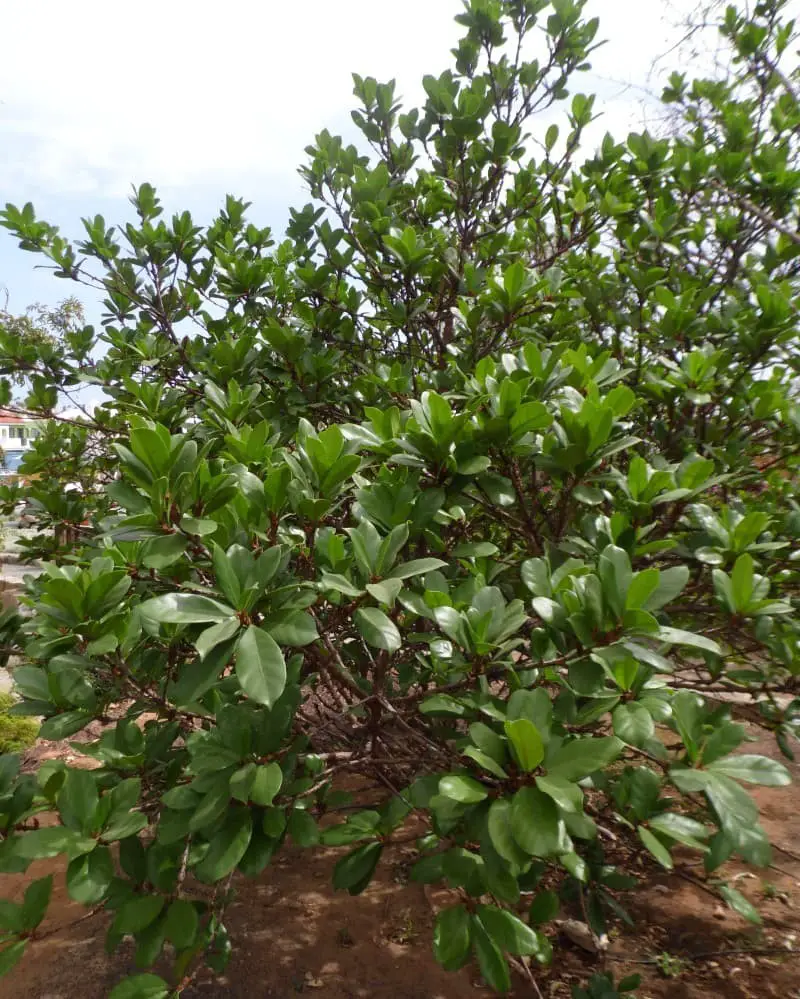
The African fig tree, a species of flowering plant belonging to the Moraceae family, is native to Africa and boasts an impressive height of up to 30 meters as an evergreen tree. Its oblong-shaped leaves are a striking feature, glistening with a vibrant green hue. The small, red fruits that adorn the tree’s branches are not only visually appealing but also edible, making it a popular choice for landscaping in both Africa and Australia.
Beyond its ornamental value, the African fig tree plays a significant role as a food source for humans and animals alike. Its leaves can be brewed into a tea touted for its medicinal properties, while the bark is transformed into a valuable fiber used in the textile industry. Culturally, the African fig tree holds great importance in many African societies. The Swazi people, for instance, revere it as a sacred tree, symbolizing strength and fertility.
Audrey ficus (Ficus benghalensis).
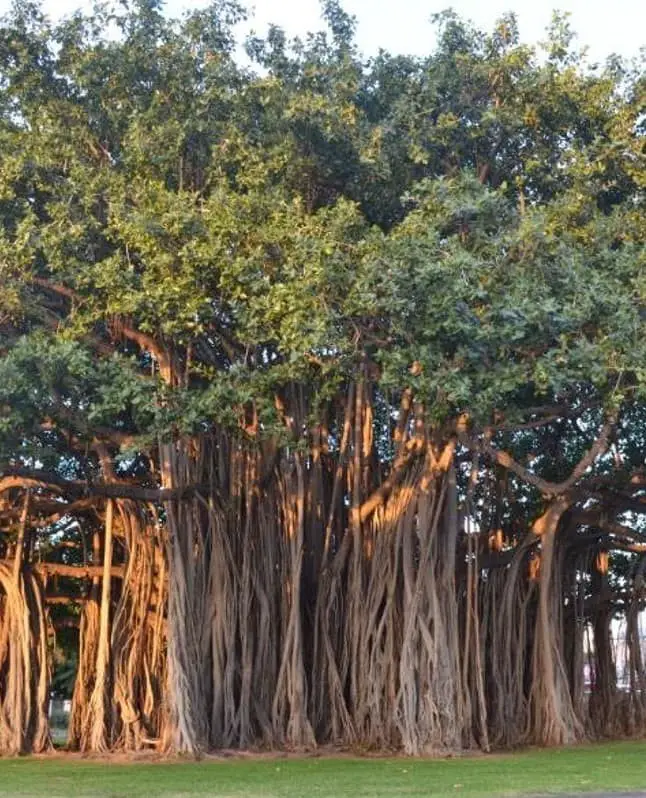
The Audrey ficus tree, a stunning specimen with large, glossy leaves and sturdy branches, is an excellent choice for any home or office setting. Its impressive growth rate can see it reach heights of up to 30 feet, making it a versatile option for spaces of various sizes. Proper pruning can even encourage further growth, allowing the tree to thrive in its new environment.
Native to India, Pakistan, and Bangladesh, this tree is also commonly known as the banyan tree, Indian fig tree, or strangler fig. The name Audrey ficus originates from the Sanskrit word ‘vata’, meaning ‘banyan tree’. This versatile plant has earned a reputation as a popular choice for indoor spaces due to its ease of care and adaptability to low-light conditions.
Additionally, it is a low-maintenance option, making it an ideal selection for those with busy schedules or limited time to devote to plant care.
Banana leaf fig (Ficus maclellandii).
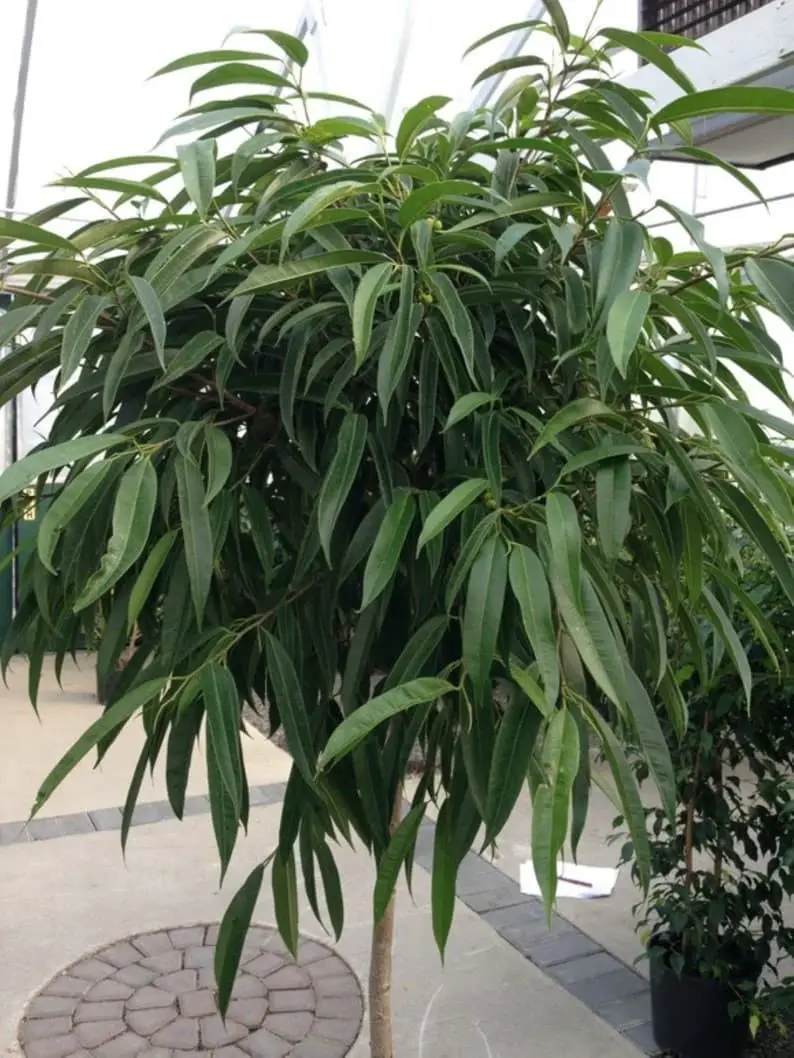
The banana leaf fig tree is a majestic evergreen native to Malaysia, Indonesia, and Thailand. Its towering stature reaches up to 30 meters in height, with massive leaves stretching up to 60 centimeters long and 20 centimeters wide. The tree’s robust trunk is wrapped in a thick layer of brown or gray bark, while its branches radiate outward at a precise 45-degree angle.
As an evergreen, the banana leaf fig tree boasts a lush canopy year-round, punctuated by small, yellowish-green flowers that bloom in clusters. These are followed by tiny, green fruits that ripen to vibrant hues of yellow or red. The tree’s wood is highly prized for crafting furniture and other products, while its leaves are valued for their utility as plates and bowls in certain cultural practices. Freshly harvested or preserved, the fruits are a delightful treat.
Burgundy Rubber Tree (Ficus elastica ‘Burgundy’).
The Burgundy Rubber Tree, a cultivar of Ficus elastica, boasts deep purple leaves with burgundy stems, making it a showstopping addition to any indoor space. This stunning houseplant has quickly become a favorite among plant enthusiasts. The Rubber Tree itself is native to tropical Asia and belongs to the Moraceae family, comprising over 800 species. In its natural habitat, this fast-growing, evergreen tree can reach impressive heights of up to 50 feet.
Developed in Europe in the early 2000s, the Burgundy cultivar has gained widespread popularity for its striking appearance. With minimal care requirements, this beautiful plant is perfect for those seeking a statement piece that’s easy to maintain. If you’re looking for a showstopping addition to your home decor, the Burgundy Rubber Tree is an excellent choice.
Clown Fig (Ficus aspera parcelli).
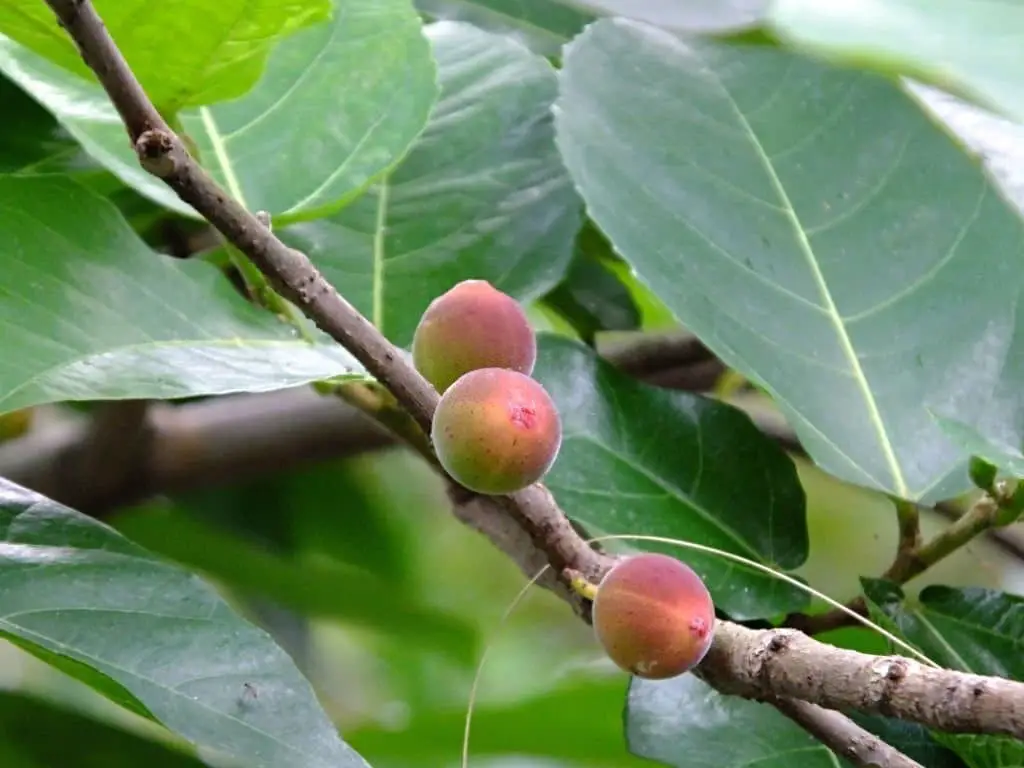
Native to Malaysia, the clown fig (a type of ficus tree) earns its name from the striking white flowers that bloom on its branches, resembling clowns with their bright red noses. However, these unique trees are not typically found in nurseries or gardens due to the challenges of cultivating them. To thrive, clown figs require ample sunlight and water, as well as regular fertilization.
If you’re considering bringing a clown fig into your outdoor space, be sure to assess whether it will fit comfortably amidst its predicted growth of up to 30 feet tall.
Common Fig (Ficus carica).
The common fig tree, a deciduous species, can reach remarkable heights of up to 30 feet. Its large, lobed leaves boast a leathery texture, while the fruit takes on an oblong or pear-shaped appearance, often featuring a greenish-yellow hue with subtle pink or purple undertones. The flesh within is characterized by a vibrant pink or red color, accompanied by tiny, black seeds. This ancient tree has its roots in the Mediterranean region, where it has been cultivated for centuries.
Its fruit has become a staple ingredient in many cuisines, while the leaves are often utilized as decorative elements or wrapping materials. As a result, fig trees can be found in many gardens and public spaces, bringing a touch of elegance to their surroundings.
Council Tree (Ficus altissima).
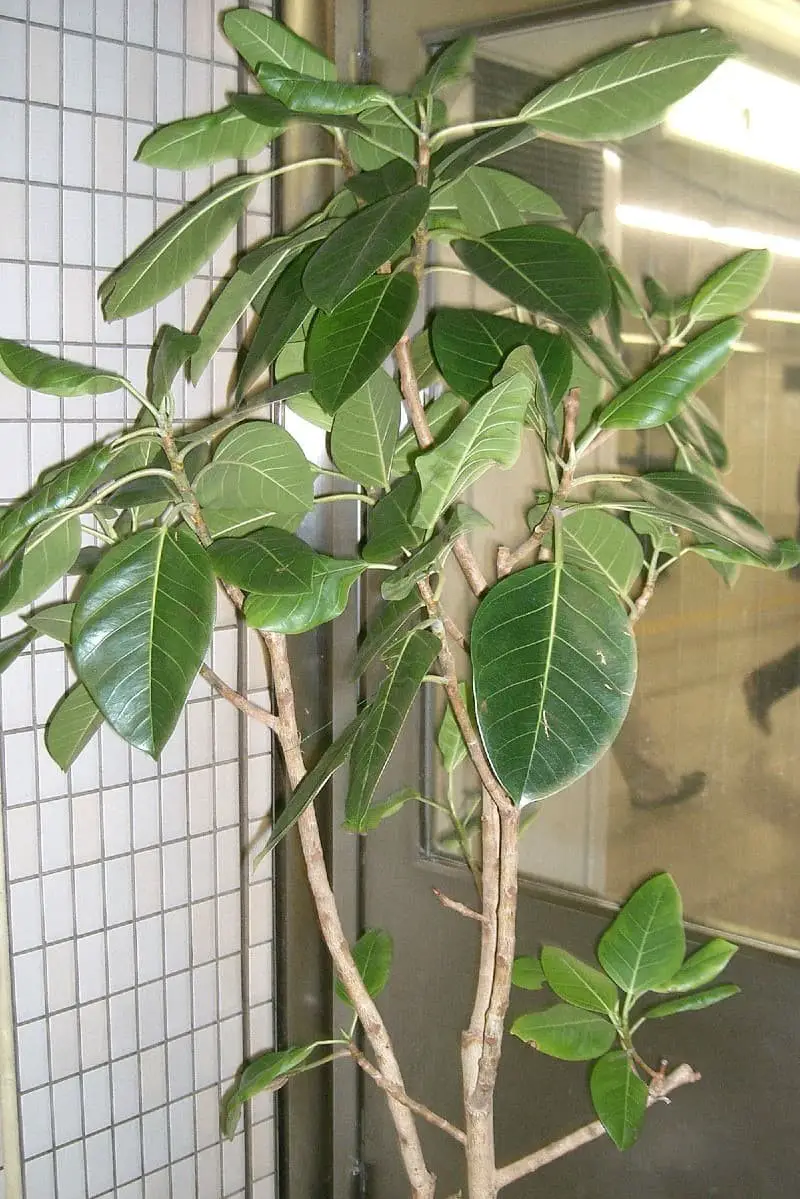
In tropical regions, one can find the unique Council Tree, a type of Fig tree characterized by its leaves’ arrangement on the branches, reminiscent of a meeting or council. This evergreen tree can reach impressive heights of up to 30 meters, with a straight trunk and smooth gray or brown bark. The large, leathery leaves boast a deep green hue, while small white flowers bloom in clusters. The fruit, a small red fig, adds to the tree’s charm.
The Council Tree holds significant cultural importance, often being considered sacred by some cultures. Additionally, it serves as a vital source of sustenance and shelter for various animals.
Creeping Fig (Ficus pumila).
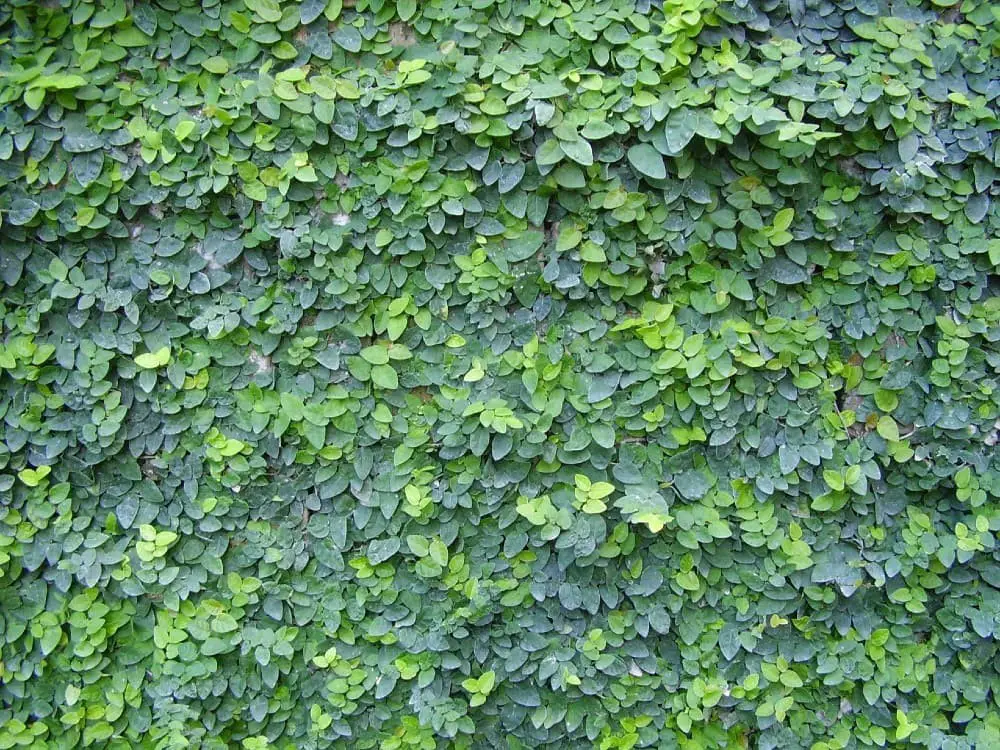
The Ficus pumila, commonly referred to as the creeping fig or climbing fig, is a rapidly spreading vine native to East Asia. As a member of the Moraceae family, this plant can grow up to 30 meters in length if left uncontrolled. Its compact leaves, typically under five centimeters long, are ovate-shaped and feature a glossy surface. The inconspicuous white flowers appear on separate male and female plants, while the fruit takes the form of small black figs, from which the plant derives its name.
As an aggressive climber, the creeping fig has a tendency to swiftly cover any available surface, posing potential risks to brickwork, stonework, and even concrete structures. The plant’s ability to produce adventitious roots along its stems allows it to attach itself to surfaces and ascend. For homeowners with creeping figs in their gardens, monitoring the plants’ growth is crucial to prevent damage to surrounding structures.
Ficus Daniella (Ficus Moclame).
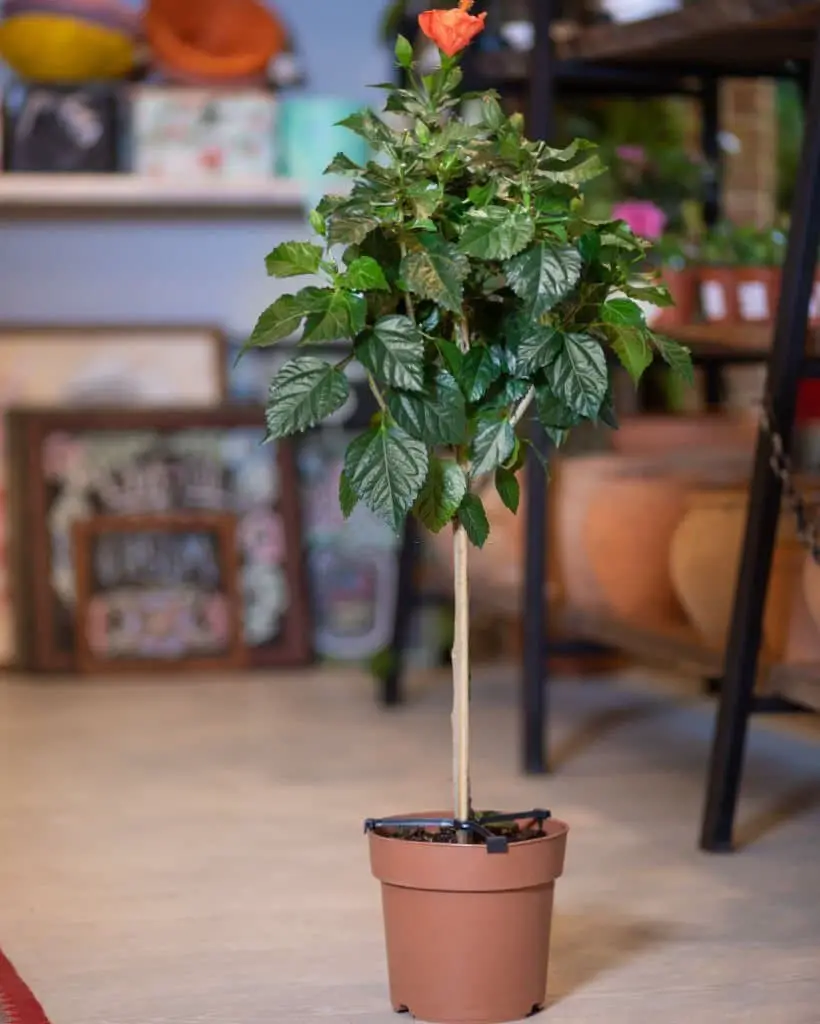
The Daniella ficus, a member of the Moraceae family also known as Ficus Moclame, originates from Brazil but has been naturalized in other South American countries. Its introduced presence is also felt in Africa and Asia. This compact tree or shrub can reach heights of up to 20 feet, boasting dark green and glossy leaves. Its small white flowers are accompanied by a blackberry-like drupe as its fruit. As an evergreen plant, it thrives in full sun or partial shade, requiring well-drained soil.
The Daniella ficus is surprisingly resilient, tolerating droughts and occasional flooding. Propagation can occur through seeds or cuttings, although it’s essential to note that this plant can be invasive in certain regions.
Fiddle-Leaf fig (Ficus lyrata).
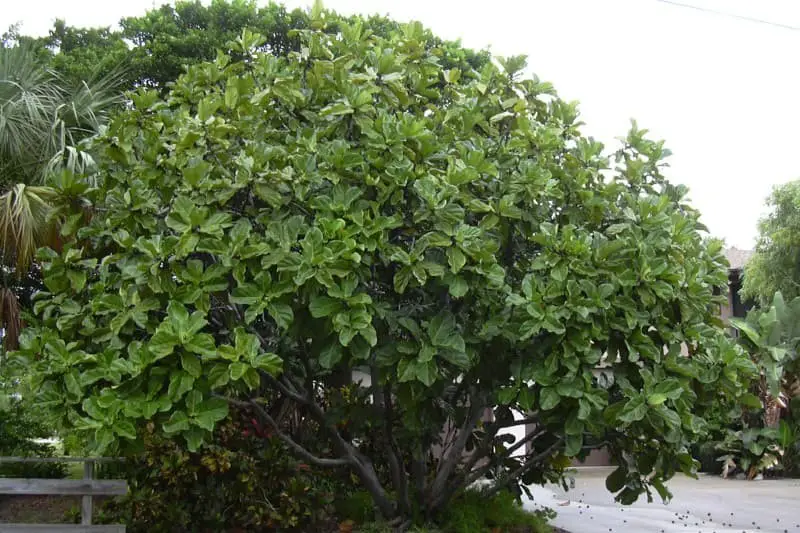
In the world of botany, the Ficus lyrata stands out as a striking specimen. Its common name, the fiddle-leaf fig tree, is derived from the remarkable shape of its leaves – large and deeply lobed, evoking the curves of a fiddle or violin. Native to tropical Africa, this species of fig can reach impressive heights of up to 20 meters in its natural habitat. However, when cultivated in containers, it tends to be significantly smaller.
Despite its size constraints, the fiddle-leaf fig tree remains a beloved houseplant due to its low-maintenance requirements and the elegant touch it brings to any room through its lush foliage.
Indian Banyan (Ficus benghalensis).
The Indian Banyan tree is a majestic sight to behold, with its sprawling canopy of dark green leaves stretching up to 30 meters tall. Its sturdy branches are thick and woody, providing shelter and shade from the elements. Indigenous to the Indian subcontinent, this remarkable tree can be found thriving in various parts of India, Pakistan, Bangladesh, and Sri Lanka. In Hindu culture, the Indian Banyan is revered as a sacred entity, often situated near temples and other places of worship.
Its perceived luckiness has led many to cultivate it in their homes and gardens, believing its presence will bring good fortune. Additionally, enthusiasts prize this tree for bonsai cultivation, while its leaves have been used in traditional medicine for centuries.
Indian Laurel (Ficus microcarpa)
Native to Asia, specifically India and Sri Lanka, the Indian Laurel (a species of fig) is a popular choice for gardens and parks due to its low maintenance requirements. This evergreen tree can reach impressive heights of up to 30m tall with a spread of 20m, boasting dark green and glossy leaves that remain throughout the year. Its branches are adorned with small, reddish-brown buds, while tiny yellow flowers bloom in the spring, giving way to small, red figs that ripen in the summer.
Characterized by its ability to thrive in a variety of conditions, the Indian Laurel is an ideal option for those seeking a tree that requires minimal watering and upkeep.
Long Leaf Ficus (Ficus binnendijkii)
Native to Southeast Asia, the long leaf ficus (Ficus binnendijkii) boasts an impressive array of characteristics that have earned it a special place in tropical landscapes. Its large leaves can reach lengths of up to three feet, while its unique fruit takes the form of small, greenish-yellow figs. A versatile tree indeed, the long leaf ficus is often employed as a shade tree or ornamental piece, and its presence can be found in many public parks and gardens.
When it comes to growth rates, this species excels, capable of reaching heights of up to 30 feet within just a few years. For bonsai enthusiasts, the long leaf ficus offers endless possibilities, allowing for creative expression through training and shaping. Furthermore, this tree is remarkably low-maintenance, making it an attractive choice for those seeking a hassle-free arboreal companion.
Mistletoe Fig (Ficus deltoidea)
The Mistletoe fig tree belongs to the Moraceae family, also known as mulberry family. Its simple, alternate leaves feature an entire margin, with a smooth, hairless surface and leathery texture. This evergreen tree can reach impressive heights of up to 30 meters tall.
Native to Southeast Asia, the Mistletoe fig tree is found in countries such as India, Sri Lanka, Malaysia, Indonesia, and the Philippines. Interestingly, it’s also known as the Curtain Fig tree in Australia.
Its widespread distribution highlights its adaptability to different environments.
The leaves of the Mistletoe fig tree have medicinal properties, used to treat various gastrointestinal disorders like diarrhea and dysentery. Additionally, they’re employed to alleviate respiratory issues such as asthma and bronchitis.
As for its physical characteristics, the flowers are small and yellow, growing in clusters. The fruit is a small, red berry containing seeds.
Moreton Bay Fig (Ficus macrophylla)
In the Australian landscape, one iconic tree stands out for its grandeur: the Moreton Bay fig. Reaching heights of up to 60m, this evergreen giant is a common sight in Queensland’s Moreton Bay region, where it thrives under the subtropical climate. Its massive trunk and sprawling canopy make it a sought-after choice for parks and gardens, providing shelter from the sun and home to a variety of birds and animals that nest in its hollows.
As a member of the Ficus genus, which includes all fig tree species, the Moreton Bay fig shares close ties with the banyan tree (Ficus bengalensis). This majestic tree has also captured the imagination of artists, photographers, and filmmakers, featuring prominently in many Australian-set films and TV shows.
Narrow Leaf fig (Ficus maclellandii ‘Alii’)
The Narrow Leaf Fig (Ficus maclellandii ‘Alii’) is a unique species of fig tree originating from Southeast Asia. Its most distinctive feature is its elongated leaves, which can reach lengths of up to 12 inches, providing a striking visual contrast. This tree can grow quite tall, reaching heights of up to 30 feet, and produces small, yellowish-green fruits as a result of its natural growth cycle.
As a popular choice for indoor cultivation and bonsai techniques, the Narrow Leaf Fig is renowned for its versatility. However, it does present certain challenges, requiring an environment with high humidity levels and sufficient sunlight exposure. For those considering cultivating this species, it is essential to factor in the time and dedication required to provide optimal care and maintenance.
Petiolate Fig (Ficus petiolaris)
The petiolate fig tree is a remarkable species native to tropical America, characterized by its striking features. Its leaves are large and boast long, slender petioles that set them apart from other trees. The fruit of this tree is not only edible but also sweet to taste. When it comes to landscaping, the petiolate fig tree is a popular choice for gardens and parks due to its fast growth rate and ability to reach heights of up to 30 meters (98 feet).
Red Leaf Fig (Ficus congesta)

In the lush rainforests of South America, Africa, and Southeast Asia, the red leaf fig tree thrives as a majestic tropical species known scientifically as Ficus congesta. This towering giant can reach heights of over 100 feet and boast trunks up to two feet in diameter, its robust stature a testament to its ability to adapt to diverse environments.
The tree’s dark green leaves glisten with a glossy sheen, their edges tinged with a reddish-purple hue that adds an air of vibrancy to the surrounding foliage. As the seasons unfold, small yellowish-green flowers emerge, gradually ripening into succulent red or purple fruits that provide sustenance for a diverse array of wildlife, including monkeys, birds, and bats.
Beyond its ecological importance, the red leaf fig tree has also played a significant role in traditional medicine practices among indigenous communities in South America and Africa, underscoring its cultural significance within these regions.
Retusa Bonsai (Ficus retusa)
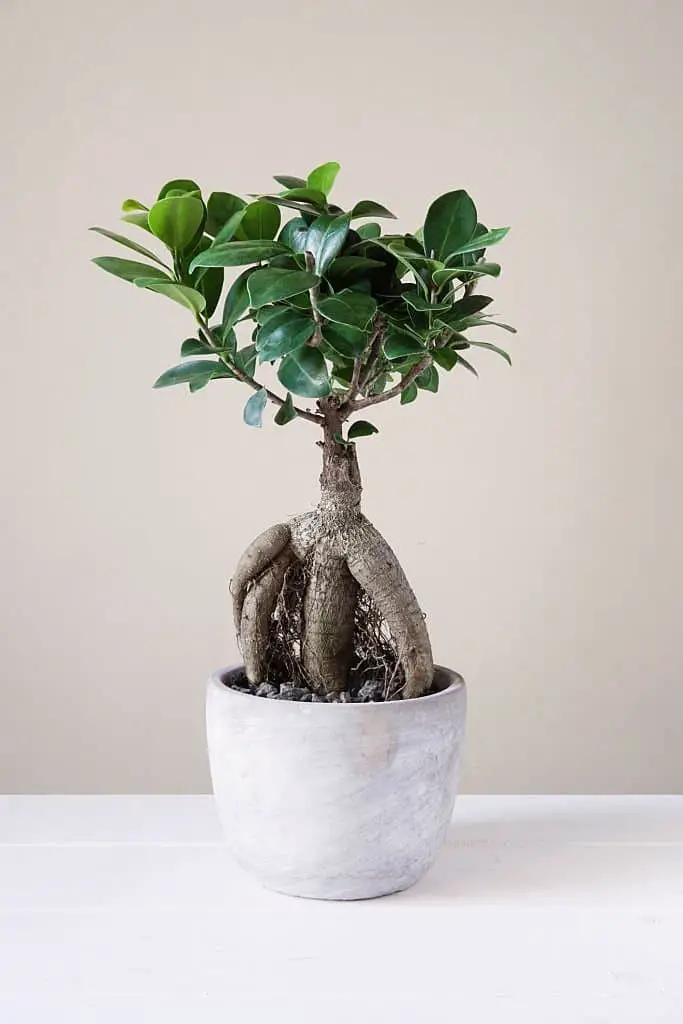
The Retusa bonsai, originating from Southeast Asia, belongs to the Moraceae family, which also encompasses popular species like Ficus microcarpa. Characterized by small, dark green leaves and a compact growth habit, this tropical tree produces tiny white flowers that ripen into yellow-orange fruits when young. Its adaptability makes it an ideal choice for beginners, as it can thrive in both indoor and outdoor settings, tolerating full sun or partial shade.
Watering is also relatively effortless, with the tree able to withstand some drought conditions. While it’s crucial not to let the soil dry out completely, the Retusa bonsai’s low-maintenance nature makes it a great option for those new to bonsai cultivation.
Rubber Tree (Ficus elastica)
Native to South America, rubber trees have adapted to thrive in numerous tropical regions globally. These plants are characterized by their ability to produce latex, a key component in the production of natural rubber. In order to flourish, rubber trees require abundant bright light and consistent moisture levels. Horticulturally inclined individuals can cultivate these plants in containers or directly in the soil, making them a versatile option for gardeners.
Sacred Fig (Ficus religiosa)
The majestic Ficus religiosa, also known as the sacred fig tree, can reach astonishing heights of up to 30 meters. Its leaves are characterized by a leathery texture and substantial size. In contrast, its flowers are diminutive and boast a greenish-white hue. The fruit, a small berry, is often seen in shades of red or black. Native to the Indian subcontinent, this remarkable tree has been revered across various cultures for centuries.
In Hinduism, it’s hailed as the ‘Tree of Life’, symbolizing immortality, while in Buddhism, it’s recognized as the ‘Bodhi Tree’, where the Buddha attained enlightenment. Similarly, in Jainism, it’s referred to as the ‘Tree of Nirvana’, embodying liberation from the cycle of birth and death.
Sandpaper Fig (Ficus coronata)
The sandpaper fig, an indigenous Australian species, earns its name from the coarse, sandy texture of its leaves. This majestic evergreen can reach heights of up to 35 meters, boasting a densely spreading canopy that provides ample shade. Its trunk and branches are clothed in thick, dark green leaves featuring slightly wavy margins. The undersides of these leaves showcase a paler green hue, punctuated by tiny, sharp hairs.
In addition to its striking foliage, the sandpaper fig also produces small, yellowish-green flowers that cluster along its trunk and branches. These blooms are eventually followed by small, rounded fruits that transform into a deep red hue as they mature.
Native to the rainforests, coastal forests, and woodlands of Queensland, New South Wales, and Victoria, this tree has become a popular choice for gardens and parks due to its attractive foliage and dense canopy, making it an ideal addition to any landscape.
Sycamore Fig (Ficus sycomorus)
The sycamore fig tree, native to Africa and the Middle East, can grow up to 30 meters tall, making it a prominent deciduous tree in its natural habitats. However, it has also been introduced to other regions, including Australia, where it is now regarded as an invasive species due to its rapid growth and ability to outcompete native flora. The sycamore fig’s unique characteristics include its large, rounded leaves that resemble those of the sycamore tree, earning it this namesake.
Additionally, its resemblance to the banyan tree has led to it being referred to as the ‘false banyan’, a nod to its miniature yet striking appearance.
Variegated Rubber Tree (Ficus elastica ‘Ruby’)
A striking feature of the variegated rubber tree is its unique foliage, characterized by leaves with alternating white and green stripes. Additionally, these leaves are more elongated than those of the standard rubber tree. This distinctive plant is native to Indonesia, Malaysia, and Thailand, where it was first introduced to European botanists in the early 19th century. Later, it made its way to American soil in the mid-1800s.
When grown outdoors, this majestic tree can reach impressive heights of up to 50 feet and widths of approximately 30 feet. Its leaves measure a substantial 12 inches in length, while the trunk remains sturdy at two to three feet in diameter. As an indoor plant, it has gained popularity due to its low-maintenance requirements, ability to thrive in moderate light conditions, and tolerance for a wide range of temperatures.
Weeping Fig (Ficus benjamina)
The weeping fig tree, Ficus benjamina, is an evergreen with a striking appearance. Its dark green leaves are glossy and its slender, drooping branches create a unique silhouette. The smooth grey bark adds to the tree’s understated elegance. Native to Southeast Asia, this versatile species has been introduced to many regions worldwide, including the United States, where it’s a popular choice for indoor cultivation due to its ability to thrive in low-light conditions.
However, weeping fig trees do require regular watering and occasional fertilization to stay healthy. In areas with cold winters, it’s essential to provide winter protection or bring the tree indoors to ensure its survival. Furthermore, these trees are susceptible to various pests and diseases, such as scale insects, mealybugs, spider mites, root rot, and leaf spot, making regular monitoring and maintenance crucial.
How to care for ficus tree outdoors
For many homeowners, Ficus trees are an attractive option due to their resilience and simplicity of care. When grown outdoors, these robust plants can reach impressive heights of 30 feet or more. While they require minimal upkeep, there are a few essential tasks to ensure the health and vibrancy of your Ficus tree.
To achieve this, follow these simple tips for caring for your outdoor Ficus: Firstly, provide it with an area that receives at least six hours of direct sunlight daily, as Ficus trees rely on this amount of solar radiation to flourish. Additionally, maintain consistently moist soil by watering deeply and regularly – roughly once a week. Furthermore, incorporate balanced fertilizers every two to three months during the growth period to promote overall health.
Finally, prune your Ficus tree annually to remove any dead or damaged branches, thereby maintaining its aesthetic appeal.
How to care for ficus tree indoors.
When it comes to cultivating a thriving ficus tree in your home, a few key factors come into play. First and foremost, provide your tree with bright, indirect light – direct sunlight may require adjustments to its watering schedule. Next, keep the soil consistently moist but not waterlogged; simply check the top inch for dryness before giving it another drink. To promote healthy growth, treat your ficus to a balanced fertilizer every two to four weeks during the growing season.
And finally, prune your tree regularly to control its size and shape – just be sure to use clean, sharp tools to avoid causing any damage.
FAQs about ficus trees
Are ficus and fig trees the same?
While it’s true that both ficus and fig trees share a common family heritage, they are distinct species with unique characteristics. The former is a type of flowering plant, whereas the latter is a fruit tree. Ficus trees do not produce edible fruits, unlike their fig counterparts. This dichotomy extends to their geographical origins as well, with ficus trees hailing from tropical regions and fig trees originating in temperate zones.
Furthermore, while ficus trees can grow to astonishing heights of up to 50 feet, fig trees typically cap out at around 30 feet tall, underscoring the notable size difference between the two.
What is the life expectancy of a ficus tree?
While the average lifespan of a ficus tree typically falls within a range of 10 to 15 years, it’s not uncommon for certain individuals to defy this norm and thrive for well over five decades. In fact, some remarkable cases have been documented where ficus trees have lived for an astonishing 50 years or more.
How many varieties of ficus trees are there?
With origins tracing back to the lush tropics and subtropics, the Ficus tree has evolved into a remarkable genus comprising more than 800 species – a testament to its adaptability and resilience. As one of the most diverse and widespread plant groups globally, Ficus trees continue to thrive in their natural habitats, showcasing their remarkable ability to flourish in varying environmental conditions.
Which Ficus is best for indoors?
When seeking a Ficus that suits your needs, several factors come into play. If you’re after a larger specimen that can provide ample shade, the Weeping Fig (Ficus benjamina) is likely your top choice. In contrast, for a more compact and low-light tolerant option, the Dwarf Rubber Plant (Ficus elastica ‘Decora’) might be a better fit. On the other hand, if you’re interested in growing a Ficus that produces fruit, the Common Fig (Ficus carica) is the way to go.
However, it’s essential to note that all these plants can be finicky indoors and notorious for dropping their leaves, so those seeking low-maintenance options might need to look elsewhere.
Conclusion
Ficus trees are a diverse and captivating group of plants that thrive in numerous environments worldwide. From compact shrubs to majestic evergreens, there’s a ficus tree to complement any landscape. With such a vast array of species available, it’s effortless to discover the ideal ficus tree for your home.
Related Posts
Discover the fascinating world of online plant nurseries, where the variety of trees on offer can be as diverse as an apple tree’s fruit or an evergreen’s resilience. But if you’re interested in making a career out of working with these natural wonders, you’ll need to know how to become an arborist – and that’s exactly what our guide is here for.
With the right knowledge, you’ll be able to assess the impact trees have on your property, whether it’s boosting its appeal or requiring removal to let in some sunshine. Meanwhile, if you’re looking to grow a little something special in your own garden, why not try cultivating an organic blueberry plant? Or perhaps you’d like to learn how to care for a lady palm, with its elegant fronds and ability to thrive in low-light conditions.
Whatever your interest, we’ve got the information you need to get started.






